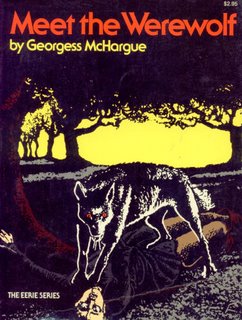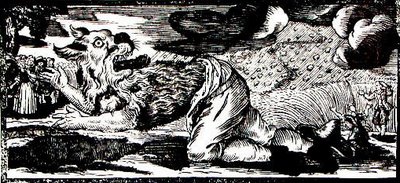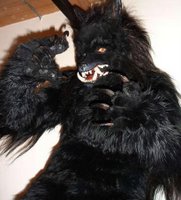I had originally intended to post a week’s worth of essays on various thoughts and topics related to Halloween . . . but real life intervened (in the form of writing and work and a strange obsession with something called Guitar Hero III). So you’re stuck with a stubbed off Halloweek series and the cold comfort that you’ll never hear my thoughts on The Exorcist and Oingo Boingo and whatever else I could summon out of my diseased wits — at least, for this year.
At some point in my childhood, I got interested in the classic Universal Studios movie monsters. I remembering a book that we ordered from school — oh, those Scholastic Books order forms, that thin catalog and order form that was impossible to fill out without tearing the flimsy paper — which had a chapter on each of the classic monsters. The book was little more than a crib sheet for each movie with a kid-friendly plot summary, some trivia about the movie, and a couple of black and white pictures in each chapter.
For some reason, I read it over and over again. It was probably my first exposure to those movies and the story behind each of the monsters that invariably cropped up in Hallowe’en decorations every year. I remember that the writing was pretty engaging and the descriptions of the costumes and special effects was my first look at “behind the scenes” of a movie.
At about the same time, I discovered that one of the local TV stations was showing old monster movies on Saturday afternoons. So once the morning cartoons were done, I could settle down in front of what (in my memory) was almost always a Godzilla movie. But every so often, there’d be a sci-fi/horror flick like “It Came From Outer Space” or even a rare appearance by one of the Universal monsters.
I remember catching “The Wolf Man” halfway through one of Lon Chaney, Jr.’s transformations. I do not remember being frightened. I remember being fascinated by this strange, almost mythological creature and the murky, moonlit world through which it prowled. And I remember going back and reading the Wolf Man chapter in that movie book over and over again.

Flash forward a few years and I’m in a different school. The usual Scholastic order forms go around and there’s a book called “Meet the Werewolf” on the list, with a rudimentary illustration of Universal’s version on the cover. Given my enthusiasm for the first book, it was a no-brainer to put this one on the list.
A few weeks later, the book arrived along with whatever others I managed to cajole out of my parents. I remember my teacher going around the room, handing the little stacks out to each student. When I got mine, the first thing I did was read the werewolf book.
I can remember the fake wood veneer of the desktop, the spine of the cheap paperback cracking as I opened it, the rough newsprint feel of the paper. The boy was a fascinating history of the werewolf in legend and folklore, starting with the actual Inquisition-era trials in Europe.
I remember rushing through my schoolwork so I could keep reading, sitting out on the playground with it as I pored over the story of Gilles Garnier and so many others. Fascinating stuff.
Then I came to the chapter titled, as I recall, “How to Become a Werewolf” . . . and everything changed.
At that point, the book began to spell out, step by step, the different methods by which one could become a werewolf — the fire in the woods, the dark man who would appear, the magic salve or belt or skin he brought. The spells were listed in detail, with the incantations scripted out: Spirit of the trees, be kind to me…
To recap from yesterday, I grew up steeped in the mainstream American Christianity of the 1970’s and ’80’s. So I knew without a doubt that Satan and all his demons were active in the world, using music and movies to ensnare the souls of humanity . . . no one had told me he was using books, too.
I was a good kid. I usually did the right thing. So I closed the book, more than a little frightened by what I had read (and probably feeling a little guilty as well, I was that sort of kid). At home that afternoon, I explained to my mom what I thought we’d ordered and then showed her what it turned out to be. We talked for a while, then more when my dad came home from work. I think a concerned call might have been made to the school. The book got trashed.
I was genuinely frightened. I hadn’t ever, ever entertained the idea that these monsters were real. But learning the history, seeing those the detailed spells . . . well, I had no doubt that werewolves were real, that they could be anyone, anywhere.
That’s a long way to go, I know, in order to talk about werewolves and why they fascinate me. That early fear faded pretty rapidly. It wasn’t too long afterwards that I wished I had kept my mouth shut, so I could keep reading and rereading those history and folklore chapters over and over again. Fortunately, I ordered a pseudo “In Search Of” book a few months later that had a couple of chapters on feral children, which helped tide me over.

Gruesomeness aside, I have to admit I was (and remain) more than a little intrigued by the werewolf, the duality inherent in the idea itself. I see it now as an excellent storytelling engine. But I think the appeal was (and remains) deeper than that. There is something about the idea that we can shed who we are, that we can unleash an inner power unencumbered by our soft, weak humanity . . . that we can be as we truly should be.
It’s the moon, it’s Dionysus, it’s the wolf itself . . . a quiet and lovely, graceful creature that lives freely on the outskirts, in the dark.
A few months ago, I was doing some research for the project I’m working on right now, digging through traditional Gothic horror constructions and themes. I allowed myself to get sidetracked in my research by all of the old werewolf folklore that I recalled with such fond interest.
One little nugget from that side trip caught my attention in a blaze of recognition and revelation: In every culture of the world, there is a variation on lycanthropy deeply rooted in the folklore. Everyone tells the story of a man who changes into a beast. Sometimes it’s a wolf, sometimes a leopard, sometimes it’s a bear.
What’s most telling about this is that, in every culture without exception, the lycanthropic shift is always to whatever the largest predator in the region happens to be. In eastern Europe, for instance, we change into wolves because that is the natural competitor, the closest threat to our food supply and our lives.
We become, then, our enemy — the one who might overtake us, outpace us in the evolutionary race . . . the one who can steal our world from us.
I don’t like werewolf movies for the most part. They never really seem to get it right. Each has its appeal — a good performance, a cool special effect, an interesting plot twist — but then they screw it up somehow.
“An American Werewolf in London” is probably one of the best ones that I can think of offhand. I also had some guilty pleasure watching the “Ginger Snaps” movie, as well.
I had high hopes for but really, really disliked “Wolf” — although it does have the best urinal joke in the world (“Asparagus.”)
I haven’t read much of werewolf fiction. Stephen King’s “Cycle of the Werewolf” stands out in my memory as a fairly good one. And I remember reading a copy of “The Howling” that my brother got at the library — I was a little young for that one, the frank sexuality of it.
A few years back, I heard Michael Chabon read his short story “Werewolves in Their Youth” on the radio program This American Life. It’s a masterful blending of childhood innocence and the horrors of being enslaved by the beast. It remains one of my favorite pieces of werewolf fiction — although, there was that one Barney Miller episode…
 I’ve written about werewolves twice — once in a veiled way and then in another more obvious approach. Neither worked very well but somewhere on my hard drive is about twenty or thirty pages of a play that I might finish one day. And even as recent as a month or so ago, I had a couple of random thoughts collide with all the werewolf folklore in my head, producing a very rough idea for one of those I-have-no-idea-what-it’ll-turn-out-to-be projects.
I’ve written about werewolves twice — once in a veiled way and then in another more obvious approach. Neither worked very well but somewhere on my hard drive is about twenty or thirty pages of a play that I might finish one day. And even as recent as a month or so ago, I had a couple of random thoughts collide with all the werewolf folklore in my head, producing a very rough idea for one of those I-have-no-idea-what-it’ll-turn-out-to-be projects.
I toyed seriously with being a werewolf this Hallowe’en. However, I’m signed up to do playground duty at my daughter’s school on that day. I don’t know how well it would go over . . . but I bet the kids wouldn’t get out of line.